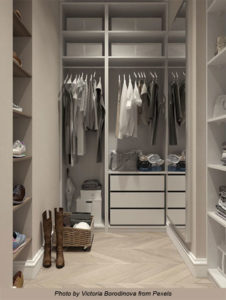It’s that time of year again – Spring cleaning! And given that we’re under quarantine due to COVID-19, we have plenty of time to dive right in!
This year, I decided to avail myself of the one of the world’s leading experts on the subject, Marie Kondo. Her book – The Life-Changing Magic of Tidying Up: The Japanese Art of Decluttering and Organizing – presents the basic principles behind her renowned KonMari Method.
She begins by admonishing readers to take this exercise seriously; half-hearted cleaning won’t get the job done thoroughly and completely. She also advocates a two-step process: discarding all non-essential items, and then figuring out where everything should go.
 To get into the right mind set for discarding, it’s helpful to set a clear intention for the exercise. It goes beyond the simple, “I want a tidy home” or “I want less stuff.” We’re challenged to explore the reasons why tidiness and having less stuff matter. For me, it’s two-fold. On a practical level, I anticipate that my husband and I will downsize substantially in the coming years, and we can’t take all this stuff with us. But on a deeper level, I realize that the old stuff needs to be cleared out to create space for the next chapter of our lives to unfold.
To get into the right mind set for discarding, it’s helpful to set a clear intention for the exercise. It goes beyond the simple, “I want a tidy home” or “I want less stuff.” We’re challenged to explore the reasons why tidiness and having less stuff matter. For me, it’s two-fold. On a practical level, I anticipate that my husband and I will downsize substantially in the coming years, and we can’t take all this stuff with us. But on a deeper level, I realize that the old stuff needs to be cleared out to create space for the next chapter of our lives to unfold.
The KonMari Method proceeds from the assumption that we choose what we should keep rather than what we should discard. In particular, we place each item in our hands and ask, “Does this spark joy?” If it does, keep it; if not, discard it. She tells us not to be distracted by thoughts of being wasteful. An item may still have a useful life or contain helpful information. But if it doesn’t engender a sense of enthusiasm when held in one’s hands, it can be thanked for its service and released to a new home. (She even suggests giving a celebratory send-off to things that will depart from the house!)
The KonMari Method processes items by category, not by room. She reasons that most of us spread items across multiple rooms. Unless and until you can see everything that you’ve got in one place, it’s hard to make rational decisions about what should stay and what should go. She always follows the same sequence when working with clients:
- Clothes, in the following order: tops, bottoms, clothes that are hung, socks, underwear, bags, accessories, clothes for occasions, shoes
- Books, in the following order: general, practical, visual, magazines
- Papers, keeping only those currently in use, required for a limited time, and required indefinitely
- Miscellaneous, in the following order: CDs/DVDs, skin care products, make-up, accessories, electronic equipment, household equipment, household supplies, kitchen goods, other
- Mementos
The final category proves the most difficult and is saved for last. By the time people reach this stage, they have gained confidence in their ability to discern what truly matters in the here and now, and what has come to the end of its useful life. As she says:
“Truly precious memories will never vanish even if you discard the objects associated with them… No matter how wonderful things used to be, we cannot live in the past… [Moreover], by paring down to the volume that you can properly handle, you revitalize your relationship with your belongings.”
Having identified what you love and what you need, the next phase entails finding a spot for everything while making the habit of using all of it. (Dust is a sign of stagnant energy!) Clutter accumulates when it’s too much effort to put things away or it’s unclear where they belong. By taking the time to store things in a logical, convenient, consistent manner, it’s easy to maintain the system and forestall backsliding. She’s big on storing clothes vertically in drawers so you can see everything at a glance. She also creates compartments in drawers to create space for specific items, often availing herself of empty shoe boxes and other small containers.
The KonMari Method goes beyond establishing a tidy house. It’s an act of restoring balance among the people, their possessions, and the house they live in. It helps us focus on what we want and need in our lives and diminishes craving for worldly possessions. And, of course, it encourages us to devote our time and energy to that which lights us up.